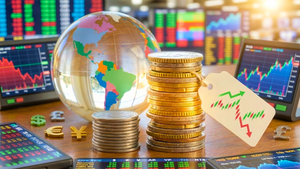
Gold has once again solidified its ancient reputation as the ultimate safe haven, shattering all previous records by surging to new all-time highs in September 2025. This historic rally, with prices soaring past $3,670 per ounce, is a direct reflection of a global landscape increasingly fraught with economic uncertainty, persistent geopolitical tensions, and the palpable anticipation of a more accommodative monetary policy from central banks worldwide, particularly the U.S. Federal Reserve. Investors, both institutional and retail, are increasingly flocking to the precious metal, viewing it as a crucial bulwark against inflation, currency devaluation, and market volatility.
The immediate implications of this gold surge are profound, signaling a collective lack of confidence in traditional financial instruments and a flight to tangible assets. As interest rates are expected to trend downwards, the opportunity cost of holding non-yielding gold diminishes, further enhancing its appeal. This monumental shift underscores a prevailing sentiment that the global economy is navigating treacherous waters, prompting a strategic re-evaluation of asset allocation by prudent investors seeking stability and wealth preservation.
The Golden Rush: Unpacking the Record-Breaking Ascent
The yellow metal's ascent to unprecedented heights has been a spectacle, marking multiple new all-time highs throughout September 2025. On September 9, 2025, gold recorded an intraday peak of $3,671.38 per ounce, with another notable record of $3,675.22 also observed within the month. This recent milestone is the culmination of a robust multi-year rally, which saw gold break the $2,900/oz barrier in February 2025 and reach $3,500/oz in April 2025. The year 2025 alone has witnessed a staggering 37% increase in gold prices year-to-date, building upon an already impressive 27% gain in 2024.
Several intertwined factors have fueled this extraordinary surge. Geopolitical uncertainty remains a dominant driver, with escalating conflicts in the Middle East and Ukraine, coupled with ongoing concerns over US tariffs and global trade policy, pushing investors towards gold's "stateless" nature. This characteristic offers value that transcends national borders and political regimes, making it an invaluable asset when traditional currencies face risks of devaluation. Moreover, persistent inflation concerns, volatile labor markets, and lingering fears of a global recession continue to underpin gold's role as an effective inflation hedge, having appreciated approximately 2.3 times the rate of core Consumer Price Index (CPI) in 2025.
Key players and stakeholders have actively contributed to this market dynamic. Central banks globally, notably those in China, India, and Turkey, have been aggressively accumulating gold, diversifying their reserves away from the U.S. dollar. In 2024, central banks purchased over 1,050 metric tons, the second-largest annual increase ever recorded, a trend that has continued with vigor into 2025, providing significant price support. Concurrently, a weakening U.S. dollar, with the Dollar Index slipping to 97.7, makes gold more affordable for international buyers, thereby boosting demand.
Initial market reactions have been overwhelmingly bullish. Gold-backed Exchange Traded Funds (ETFs) have seen substantial inflows, attracting approximately $12.3 billion in new assets year-to-date in 2025. Physical bar and coin sales have also surged, particularly in Western markets, indicating robust retail investor demand. Analysts from major financial institutions like J.P. Morgan Research are projecting further gains, with expectations for prices to average $3,675/oz by the final quarter of 2025 and potentially climbing towards $4,000/oz by Q2 2026, and even $5,000 by 2030, should current monetary policies and global challenges persist.
The Fortunes of Gold: Who Wins and Who Loses?
The unprecedented surge in gold prices creates distinct winners and losers across the financial landscape, reshaping investment portfolios and corporate strategies. The most obvious beneficiaries are gold mining companies, which stand to see significant boosts to their revenues and profitability. As the price of their primary output increases, their profit margins expand, assuming production costs remain relatively stable. Companies like Barrick Gold Corp. (NYSE: GOLD) and Newmont Corporation (NYSE: NEM) are prime examples. These mining giants, with extensive operations worldwide, will likely experience increased investor interest, potentially leading to higher stock valuations and greater capital for exploration and expansion. Similarly, companies involved in gold streaming and royalties, which receive a percentage of gold production or revenue, will also see enhanced returns.
Conversely, while gold's rise often signals broader economic apprehension, it can have nuanced impacts on other sectors. Companies heavily reliant on consumer discretionary spending might face headwinds as investors become more cautious, although this link is often indirect. Industries that thrive in periods of robust economic growth and higher interest rates, such as certain financial institutions or growth-oriented technology companies, might experience a relative slowdown in investor enthusiasm as capital rotates towards perceived safer assets. However, for most public companies not directly involved in the precious metals industry, the direct impact of gold's price increase is often minimal, serving more as a barometer of market sentiment rather than a direct driver of their performance.
For individual investors, those with allocations to gold through physical bullion, gold-backed ETFs (like SPDR Gold Shares (NYSE Arca: GLD)), or mutual funds focused on precious metals, are clearly winning. Their portfolios have benefited from capital appreciation, offering a buffer against broader market volatility. However, those who were underweight in gold or exited positions prematurely may have missed out on significant gains. Furthermore, the rising gold price might prompt a re-evaluation of portfolio diversification, as investors seek to balance risk and return in an increasingly uncertain economic environment. The increased interest in gold could also divert capital from other asset classes, potentially impacting valuations in less favored sectors.
The Golden Ripple: Broader Implications and Historical Echoes
Gold's recent surge is not an isolated event but rather a powerful indicator within broader industry trends, reflecting a profound shift in global economic and geopolitical dynamics. This rally perfectly aligns with a growing sentiment among central banks and institutional investors to de-dollarize and diversify away from traditional reserve currencies. The aggressive accumulation of gold by central banks, particularly from emerging economies, underscores a strategic move to safeguard national wealth against potential currency fluctuations and geopolitical leverage, thereby enhancing the metal's role as a sovereign asset. This trend is a significant departure from previous decades when the U.S. dollar reigned almost unchallenged as the primary reserve asset.
The ripple effects of this event extend across various markets. For other commodities, gold's performance often signals a broader inflationary environment or a weakening dollar, which can support the prices of other raw materials. However, its "safe-haven" status can also mean that capital flows are specifically directed towards gold, potentially at the expense of industrial commodities whose demand is tied to economic growth. The bond market is particularly sensitive to gold's movements, as a flight to gold can signal dwindling confidence in government debt, especially in an environment of anticipated lower interest rates, which diminishes the attractiveness of fixed-income assets. This shift could lead to higher yields for long-term bonds, as governments struggle to attract buyers in a competitive landscape for safe assets.
From a regulatory and policy perspective, the sustained high price of gold could prompt renewed discussions about monetary policy, particularly regarding inflation targeting and the role of hard assets in a nation's financial stability. Governments might face increased pressure to address the underlying economic uncertainties that are driving investors towards gold, such as national debt levels and long-term fiscal health. Historically, periods of significant gold price increases have often coincided with major global realignments or economic crises, such as the oil shocks of the 1970s or the 2008 financial crisis. The current environment, characterized by persistent inflation, geopolitical instability, and an expected dovish pivot by central banks, draws parallels to these times, reinforcing gold's historical role as a hedge against systemic risk and a barometer of global anxiety.
What Comes Next: Navigating the Golden Future
The future trajectory of gold prices, while difficult to predict with absolute certainty, appears poised for continued strength in both the short and long term, barring a dramatic shift in global economic or geopolitical conditions. In the short term, the anticipated interest rate cuts by the U.S. Federal Reserve are expected to provide further tailwinds, as lower rates reduce the opportunity cost of holding non-yielding assets like gold. Persistent geopolitical tensions and ongoing inflationary pressures will also likely sustain investor demand for gold as a safe haven. We could see gold challenge the $4,000 per ounce mark within the next six to twelve months, especially if the global economic outlook remains uncertain or deteriorates further.
From a long-term perspective, gold's appeal is likely to endure. The fundamental drivers, including increasing central bank demand, a weakening U.S. dollar, and the potential for prolonged periods of low real interest rates globally, suggest a sustained upward trend. Analysts from J.P. Morgan Research have even projected prices reaching $5,000 by 2030, indicating a belief that the current economic and monetary landscape will continue to favor gold. This outlook suggests potential strategic pivots for investors: a continued emphasis on diversification with a strong allocation to precious metals, and for mining companies, a strategic focus on expanding reserves and optimizing production to capitalize on higher prices.
Market opportunities will emerge for both traditional gold investors and those looking to enter the precious metals space. The gold mining sector, particularly companies with strong balance sheets and efficient operations, could attract further investment. Additionally, derivatives markets and gold-backed financial products may see increased activity. However, challenges also loom. A sudden resolution of geopolitical conflicts, a stronger-than-expected global economic recovery, or a surprising hawkish turn from central banks could temper gold's rally. Investors will need to closely monitor global inflation data, central bank communications, and geopolitical developments to adapt their strategies. Potential scenarios range from a steady appreciation in gold's value to more volatile price movements depending on the unfolding global narrative, underscoring the need for a dynamic and informed investment approach.
The Enduring Allure: A Comprehensive Wrap-Up
Gold's ascension to all-time highs in September 2025 represents far more than a mere price milestone; it is a potent symbol of profound shifts in global finance and a collective recalibration of risk by investors worldwide. The key takeaways from this event are clear: gold's traditional role as a safe haven has been unequivocally reinforced by persistent geopolitical instability and economic uncertainty, while the anticipation of lower interest rates has significantly enhanced its attractiveness relative to yielding assets. The robust demand from central banks, coupled with strong retail and institutional investment, underscores a broad-based conviction in gold's enduring value as a store of wealth in turbulent times.
Moving forward, the market for gold appears robust, buoyed by fundamental drivers that are unlikely to dissipate quickly. The macroeconomic environment, characterized by lingering inflation concerns, potential central bank easing, and ongoing global tensions, creates a fertile ground for gold to maintain its elevated status. While the possibility of market corrections always exists, the overarching sentiment points towards continued strength, making gold a crucial component of diversified portfolios.
In conclusion, gold's recent rally is a testament to its timeless appeal as an asset that thrives when confidence in traditional financial systems wavers. Its performance serves as a critical barometer of global risk perception and monetary policy expectations. Investors in the coming months should meticulously watch central bank decisions regarding interest rates, monitor geopolitical developments, and assess global economic indicators, particularly inflation figures. These factors will continue to shape gold's trajectory, solidifying its position as a vital asset for navigating the complexities and uncertainties of the modern financial landscape, and offering a tangible hedge in an increasingly intangible world.






